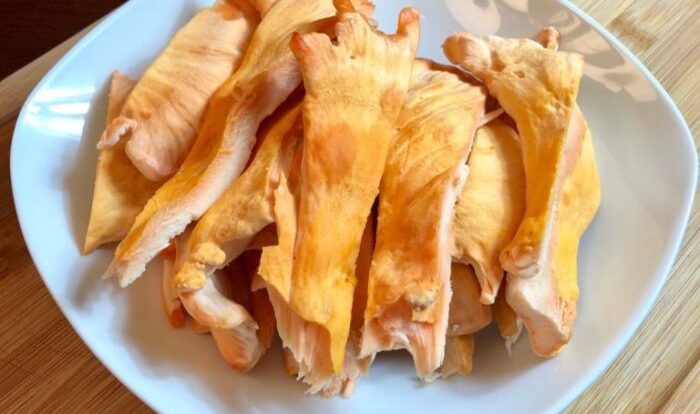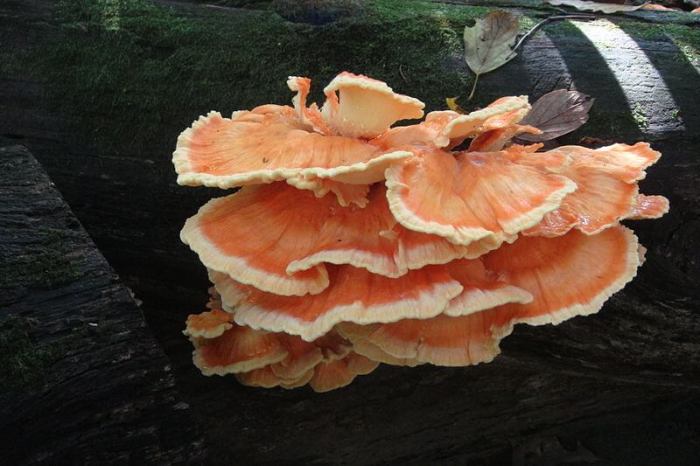
Embark on a culinary adventure with our tantalizing chicken of the woods recipe! This extraordinary mushroom offers a delectable taste of nature, brimming with nutritional goodness and culinary versatility. Dive into our guide to learn how to prepare, savor, and reap the health benefits of this woodland treasure.
Uncover the secrets of identifying chicken of the woods in the wild, ensuring responsible foraging practices. Explore its unique flavor profile and discover creative ways to incorporate it into your favorite dishes, from hearty soups to vibrant salads. Let us guide you through the art of cooking chicken of the woods, introducing you to tantalizing variations, marinades, and sauces that will elevate your culinary creations.
Recipe Exploration
Preparing Chicken of the Woods is a delightful culinary experience that can be enjoyed in various ways. Let’s dive into the step-by-step guide and explore some exciting variations to tantalize your taste buds.
If you’re looking for a delicious and unique mushroom recipe, try out the chicken of the woods recipe . This edible fungus has a meaty texture and a slightly nutty flavor that pairs well with various dishes. Whether you sauté it, grill it, or fry it, this recipe will satisfy your cravings for a tasty mushroom treat.
Cleaning and Preparation
- Clean the mushrooms thoroughly by brushing off any debris or dirt.
- Remove any tough or woody parts from the base.
- Cut the mushrooms into bite-sized pieces.
Cooking Methods
Grilling
- Preheat your grill to medium-high heat.
- Toss the mushroom pieces with olive oil, salt, and pepper.
- Grill for 5-7 minutes per side, or until golden brown and tender.
Roasting
- Preheat your oven to 400°F (200°C).
- Toss the mushroom pieces with olive oil, herbs, and spices.
- Roast for 20-25 minutes, or until caramelized and tender.
Frying
- Heat a large skillet over medium heat.
- Coat the mushroom pieces in flour or cornstarch.
- Fry for 3-5 minutes per side, or until golden brown and crispy.
Marinades and Sauces
- Lemon-Herb Marinade: Combine lemon juice, olive oil, garlic, thyme, and rosemary.
- BBQ Sauce: Brush the mushrooms with your favorite BBQ sauce.
- Creamy Garlic Sauce: Sauté garlic in butter, then add heavy cream, Parmesan cheese, and salt.
Nutritional Value

Chicken of the Woods is a nutritional powerhouse, offering an array of essential vitamins, minerals, and antioxidants. Its consumption contributes significantly to a healthy diet.
This mushroom is rich in vitamins B, C, and D. Vitamin B is crucial for energy metabolism, while vitamin C acts as an antioxidant and immune booster. Vitamin D supports bone health and immune function.
Minerals
- Potassium: Essential for regulating blood pressure and heart function.
- Phosphorus: Important for bone health, energy metabolism, and nerve function.
- Iron: Vital for red blood cell production and oxygen transport.
Antioxidants, Chicken of the woods recipe
- Ergothioneine: A potent antioxidant that protects cells from damage.
- Polyphenols: Antioxidants that reduce inflammation and improve cardiovascular health.
Flavor Profile and Culinary Applications

Chicken of the Woods boasts a unique and flavorful profile that sets it apart from other mushrooms. Its texture is tender and slightly chewy, resembling the texture of chicken. The flavor is often described as umami-rich, with a slightly sweet and nutty undertone.
The culinary versatility of Chicken of the Woods is remarkable. It can be incorporated into a wide range of dishes, enhancing their flavors and adding a unique texture. Here are some culinary applications of this delectable mushroom:
Soups and Stews
- Chicken of the Woods adds a hearty and flavorful element to soups and stews. Its meaty texture and umami flavor complement a variety of broths and ingredients.
- The mushroom can be sautéed or roasted before adding it to the soup, enhancing its depth of flavor and creating a more complex taste profile.
Salads
- Raw or cooked Chicken of the Woods can be added to salads for a unique and flavorful twist. Its meaty texture provides a satisfying bite, while its umami flavor adds a savory dimension to the salad.
- The mushroom can be paired with a variety of greens, vegetables, and dressings to create a refreshing and flavorful salad.
Stir-fries
- Chicken of the Woods is an excellent addition to stir-fries, providing a protein-rich and flavorful component. Its meaty texture holds up well to the high heat of stir-frying.
- The mushroom can be marinated in a flavorful sauce before stir-frying to enhance its taste and add complexity to the dish.
Identification and Foraging

Chicken of the Woods is a distinctive and edible mushroom that can be found in forests throughout the world. It is prized for its bright colors, meaty texture, and delicious flavor. Identifying and foraging for Chicken of the Woods requires some knowledge and experience, but it can be a rewarding and enjoyable activity.
Here are some tips for identifying and foraging for Chicken of the Woods:
Physical Characteristics
- Color:Chicken of the Woods is typically bright orange or yellow, although it can also be found in shades of red, pink, or white.
- Shape:The mushroom has a shelf-like or fan-shaped appearance, with a wavy or lobed margin.
- Size:Chicken of the Woods can grow to be quite large, with some specimens reaching up to 12 inches across.
- Texture:The flesh of the mushroom is firm and meaty, with a slightly fibrous texture.
- Habitat:Chicken of the Woods is typically found growing on dead or dying hardwood trees, especially oak, maple, and beech.
Safety Tips
- Always consult with a field guide or expert before consuming any wild mushrooms.
- Never eat a mushroom that you cannot identify with certainty.
- Collect mushrooms from areas that are free of pollution and pesticides.
- Cook mushrooms thoroughly before eating them.
- If you experience any adverse effects after eating mushrooms, seek medical attention immediately.
Health Benefits and Medicinal Uses
Chicken of the Woods possesses an array of potential health benefits, making it a valuable addition to a balanced diet. Its medicinal properties have been recognized in traditional medicine practices for centuries.
If you’re looking for a delicious and unique vegetarian meal, try out this chicken of the woods recipe . This edible fungus has a meaty texture and a savory flavor, making it a great substitute for chicken in many dishes.
Research suggests that Chicken of the Woods contains a diverse range of bioactive compounds, including polysaccharides, antioxidants, and anti-inflammatory agents. These compounds contribute to its potential health-promoting effects.
Immune System Support
- Chicken of the Woods is rich in polysaccharides, which have been shown to enhance immune function.
- Studies indicate that these polysaccharides can stimulate the production of immune cells, such as macrophages and natural killer cells, which play a crucial role in defending the body against pathogens.
Antioxidant Properties
- Chicken of the Woods contains antioxidants, such as ergothioneine and phenolic compounds, which protect cells from oxidative damage.
- Oxidative stress is associated with chronic diseases, including cancer and heart disease. Antioxidants help neutralize free radicals, reducing the risk of these conditions.
Anti-inflammatory Properties
- Chicken of the Woods has anti-inflammatory properties due to its content of polysaccharides and triterpenes.
- Inflammation is a major contributing factor to various diseases, including arthritis, asthma, and inflammatory bowel disease. Anti-inflammatory agents help reduce inflammation and alleviate symptoms.
Other Potential Health Benefits
- Chicken of the Woods may have antitumor properties, with studies suggesting it can inhibit the growth of certain cancer cells.
- It is also believed to have antimicrobial and antiviral properties, making it a potential natural remedy for infections.
Final Conclusion: Chicken Of The Woods Recipe

Our chicken of the woods recipe is not merely a culinary delight but a gateway to a healthier lifestyle. Its nutritional richness and potential medicinal properties make it a valuable addition to any health-conscious diet. Whether you’re a seasoned forager or a curious cook, this guide empowers you to embrace the wonders of chicken of the woods, transforming your meals into unforgettable experiences.
Quick FAQs
What are the key identifying features of chicken of the woods?
Chicken of the woods is characterized by its bright orange to yellow coloration, shelf-like shape, and meaty texture.
How can I ensure safe foraging practices for chicken of the woods?
Always consult with experienced foragers or use reliable field guides to accurately identify chicken of the woods. Avoid harvesting mushrooms near roads or polluted areas.
What are some creative ways to incorporate chicken of the woods into my cooking?
Experiment with grilling, roasting, or frying chicken of the woods to enhance its flavor. Add it to soups, stews, or salads for a boost of umami and texture.





